10 Simple Activities for Students of All Levels
Which is the safest place to hide information? The CIA archives or a student’s vocabulary notebook? I would go for the latter, as the former will be opened eventually, some 50 years from now. 🙂
Yet although we all recognise the importance of vocabulary revision, very few of our students do it. Why? I believe it is partly that we as teachers are always trying to ‘cover new ground’ and partly that our students do not know how to go about it.
Take 1 minute to think about the following 2 questions.
- How do your students record unknown words in their notebooks?
- Do they revise them? And if so, how?
Now compare your answers with those at the end of the article – any similarities? *
[Materials: This sequence of activities is based on a presentation I gave some time ago (see below). To download the slides, just click here. To download a handout for the students to use, click here].
Why Vocabulary Revision Strategies? “Vocabulary cannot be taught – it has to be learned” (Rivers in Thornbury, 2002). The implications of this are enormous. Because of the importance of vocabulary and the sheer amount of lexical items to be learned we cannot rely on a process of accretion whereby we ‘feed’ learners a few words at a time and hope for the best. By exposing them to a range of strategies we can achieve one or more of the following:
- Increase learners’ awareness of how they learn/remember words
- Encourage good learning habits
- Help them discover the learning style that suits them best
- Make them more independent
- Encourage them to become active learners
The Activities
What follows is a sequence of 10 activities which can be used as one lesson (of approximately 90 minutes) in class or in 1-1 teaching and at all levels, (though you might want to use slightly different words! **). The main point however is not the words themselves but rather the activities which the students can subsequently use when revising on their own.
In the interests of clarity and ease, students are given a list of 50 words that fall ‘neatly’ into categories and lend themselves to manipulation by means of the other activities that we are going to look at below. In ‘real life’ that would be a list of words that the students have encountered in previous lessons.
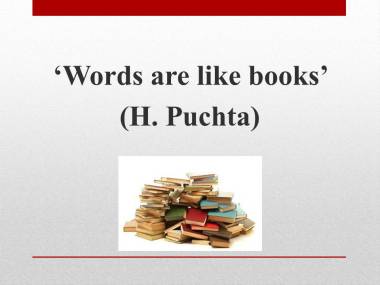
Activity 1: Grouping. [Students look at a list of words (see the first page here) and try to divide them into 5 categories. While doing that, they have to find a suitable name for the category. They then place the words ‘around’ the ‘headword’ like in a mind-map] (Idea taken from Gairns & Redman, 1986).
Comments: This is the only activity which might take some time, but it is well worth it, as it forms the basis for all the others. It also addresses an important problem found in almost all students’ notebooks: the words are listed there at random. This is inevitable during the lesson, but students should later go back and reorganize them (Thornbury, 2002). “Words are like books” (H. Puchta, TESOL Convention 2001): in the same way that if you have 1,000 books it is difficult to find the one you want unless you put them on different shelves, sorting words in groups facilitates both retention and retrieval (Nation, 2001).
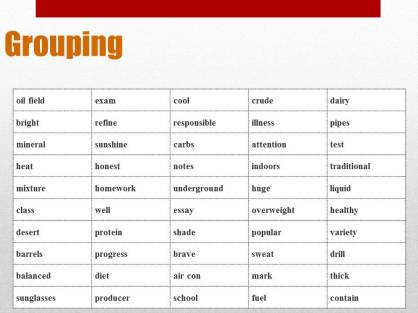
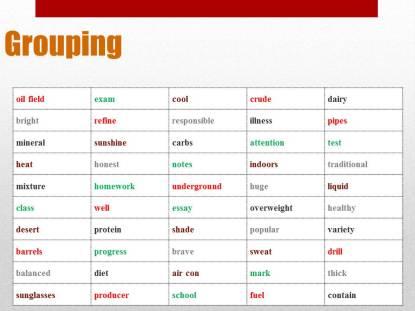
Activity 2: Pairing. [Now you can give students the second page of this worksheet. Students try to find a ‘partner’ for the words in a particular group (this works best for adjectives or verbs – e.g. cunning / a cunning fox, or cast / to cast a vote)]
Comments: How many times have your students come up with something like x ‘We wrote a test today’ x or x ‘He put me a bad mark’ x? (the latter accompanied by various expletives!). This is partly due to MTI (mother tongue interference) but also in part due to the students’ habit of recording words in isolation (e.g. vote = ψήφος / hence why not x ‘throw a vote’ x or x ‘drop a vote’ x ?). This activity aims to drive home the importance of collocation, in other words to show students that a word is virtually useless for productive purposes unless they know what other words it goes with. In addition, knowledge of typical collocations reduces the students’ cognitive load in production (Lewis, 2000).

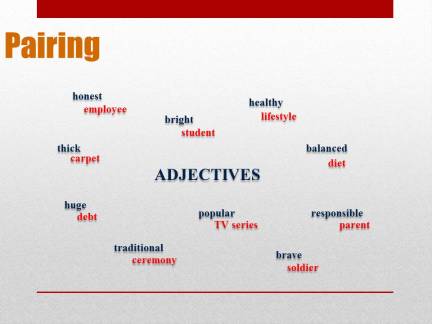
Activity 3: Brainstorming. [Students look at the words in a particular group, and try to recall others belonging to the same category] (Thornbury, 2002).
Comments: On the face of it, this may look both unnecessary and counterproductive. ‘It is hard enough getting students to learn these fifty words without introducing any new ones!’ one might say. Yet this is not so for three reasons: a) The activity forces students to do something active by tapping the vocabulary already at their command. b) By trying to think of words in the same field students subconsciously start making links between these and the new ones (Chamot, Barnhardt, El-Dinary, Robbins 1999). c) Unless you have done this activity it is difficult to do the next one!

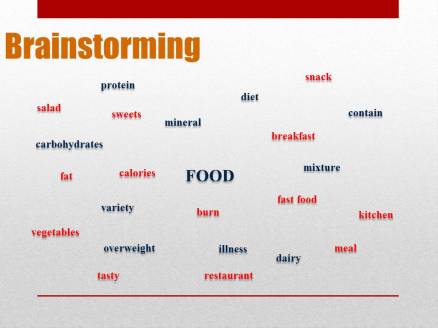
Activity 4: Linking. [Students literally ‘link’ two or more words in a category by finding some feature they have in common or some other way in which they are connected semantically – but they have to say what the connection is].

Comments: “Words are like boats” (H. Puchta, TESOL Convention 2001) – they tend to drift away when you are not looking (which in the case of my students is 99% of the time!). If you want to make sure your boat stays put, you cast an anchor or tie it somewhere. With words, the ‘ropes’ are the links with other words. The greater the number of links, the less likely you are to forget them and the easier it will be for you to retrieve them later. Manipulating words in groups provides memory links and ‘maps’ the new words onto the students’ already existing knowledge (Chamot, Barnhardt, El-Dinary, Robbins 1999).
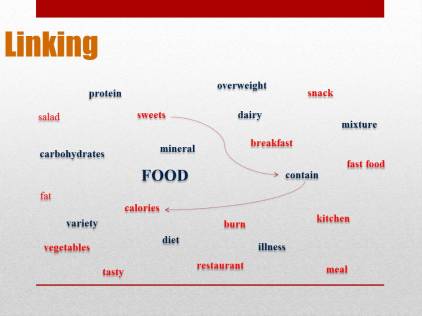
Activity 5: Focusing. [Students simply look at the words and highlight the ones they do not recall, or the ones they might find the most difficult to retrieve or use] (Mc Carthy & O’Dell, 1994).
Comments: When students do actually look at the vocabulary in their notebooks, they do so indiscriminately and if asked to revise the words they have recorded they will study them for much the same reason that Hillary climbed Everest – because they are there! Yet not all of them are equally useful or equally unfamiliar to students. Hence, it makes sense for us to encourage them to select what they focus on. Indeed, one of the distinguishing features of the good student is that s/he is selective (Chamot, Barnhardt, El-Dinary, Robbins 1999) and such students know that the highlighter is one of their strongest weapons!
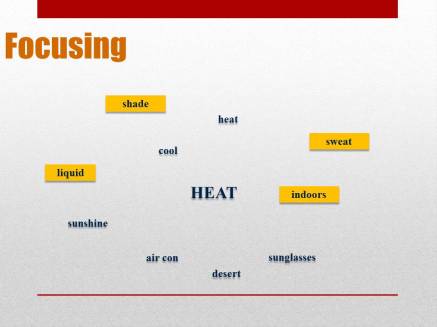
Activity 6: Recalling. [Students look at all 10 words in a particular category for about 1 minute. They then have to write them down without looking at them. After that, they compare the two lists and focus their attention on the ones they have forgotten]. (Mc Carthy & O’Dell, 1994)
Comments: Compare this with the students’ standard practice of just looking at words and trying to memorise them. All too often, their eyes travel down the page but there is no guarantee that the brain takes in the information. In this case though learners can check how effective their attempts at memorization have been and can also focus later on the words they have not managed to recall. If they do this 4-5 times (with increasing time intervals between each revision period (Gairns & Redman, 1986) their chances of retaining them are much higher (Mc Carthy & O’Dell, 1994).
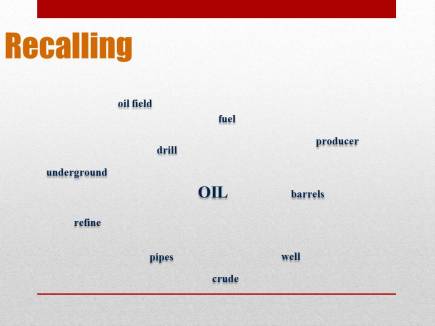
Activity 7: Associating. [Students choose a category and they try to associate each word in it with some abstract/general notion, e.g. ‘Good/Bad’ or ‘Past/Present/Future’ – but once again they need to say why].
Comments: This activity achieves 3 aims: Firstly, it creates a different kind of link; one between a word and a ‘notion’ this time. Secondly, it raises the students’ awareness of the need to record not only the meaning but the connotations of a word as this may be particularly important sometimes (compare for instance the words ‘slim’ and ‘skinny’). Finally, it shows students that the way to learn vocabulary is very often a personal one, as different people might classify the same word differently (Ellis & Sinclair, 1989).

Activity 8: Anchoring. [Students choose some of the more difficult words and deliberately set out to create ‘links’ with other related lexical items by findings superordinate and subordinate words, usual collocations, examples of the term etc.]
Comments: This activity is based on the ‘Depth of Processing’ hypothesis (see Craik & Lockhart 1972). The idea behind the creation of this mini-network is that the more semantic links one forges between a lexical item and other words / expressions (the more ‘ropes’ you tie your ‘boat’ with – see H. Puchta’s metaphor above), the more likely this item is to be remembered and the more avenues we will have of accessing it, hence the easier it will be to retrieve (Willingham 2009).
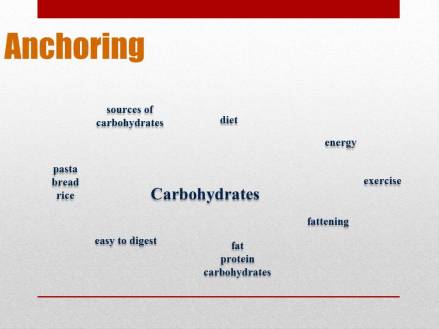
Activity 9: Using. [Similar to ‘Linking’, only here students have to link two or more words by making a sentence containing them or by combining them to produce a short text]. (Mc Carthy & O’Dell, 1994).
Comments: The purpose of this activity is not only to correct mistakes that students may make in production, but rather to print the words in their minds. It kills two birds with one stone; a) it creates yet another link between 2 words and b) according to the ‘depth of processing’ hypothesis students are more likely to remember a lexical item if they are actively engaged with it rather than if they just look at it and try to remember it (Thornbury, 2002).


Activity 10: Expanding. [Students look at one of the groups and ask themselves ‘Are there any words related to this group which I do not know in English?’ They then write them down in the L1 and either ask the teacher to translate them, or look them up in a dictionary].
Comments: This is perhaps the most ambitious activity of all. Students use the L1 to discover gaps in their knowledge of the L2 (Atkinson, 1993). However, the main aim is to make students active – to make them take responsibility for their own learning. Instead of passively recording the words they come across in a text or generally during the lesson, instead of waiting for the words to come to them, they are now asked to go out and find them for themselves.

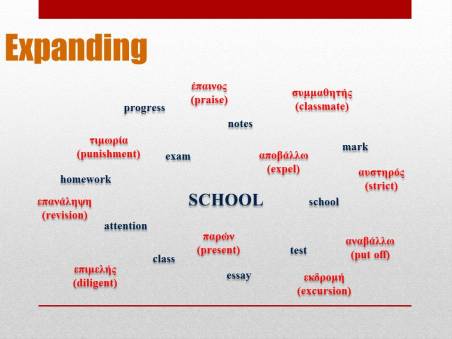
Two additional points
What about context? Well, it is true that lexical items are best presented in context (Lewis, 2000). The advantages are that students can see them being used naturally and in a natural context and so they can get much more information about them. However, here we are talking about revision. The assumption is that the words first appeared in a text and were subsequently recorded by students. When entering vocabulary in your notebook, you cannot keep the whole text. Moreover, there has been research which shows that words can be retained even outside the context of a sentence (Nation, 2001).
Doesn’t all this imply too great an emphasis on explicit learning? It is true that many have suggested that words are best acquired and we should let exposure to the language do its work. In fact the debate between the merits of implicit vs explicit teaching has been raging for some time and there is a whole spectrum of approaches from an extreme emphasis on acquisition (Krashen) to a focus on intense conscious learning (Craik & Lockhart – both in Carter & Nunan, 2001). As is often the case, the truth may well lie somewhere in between, so it makes sense to make our learners aware of both ways. Besides, different learners have different learning styles and it is for them to choose the one that suits them best (Ellis & Sinclair, 1989).
Last words – and a treat…
Two final points – honest! Firstly, although each of these activities is short and fast, ten courses in one sitting can cause serious indigestion to even the most highly-motivated students, so break them up – make sure you insert some other, fun activities before returning to the vocabulary strategies. Secondly, do not expect instant results. Strategic training takes a long time and it is mostly adults who are likely to take some of these techniques on board right from the start.
…And as a reward to you for having managed to read up to this point and seeing as we are on the subject of words here is a little treat – something on the importance of synonyms. Synonyms are great, as they can help you get your message across. If one of them doesn’t work, another one is bound to, right? 🙂
[* (1) In my experience, most of them simply make lists of the ‘cast = ρίχνω’ type. (2) No. If they do, they simply read the word pairs or, at best, they cover the translations and try to remember them and then reverse the procedure. – surely we can help them do better than that?]
[** Here are 4 more sets of words that you can use with your students at levels C2 – C1 – B2 and B1 if you want to see how these activities work (just click here). Of course it is best if you use words that your students have already encountered. These are meant to be revision strategies.]
[*** If you would like to use this video clip in class, you can click here to download a worksheet].
References
Atkinson, D. “Teaching Monolingual Classes” Longman 1993
Carter, R. & Nunan, D. “Teaching English to Speakers of Other Languages” C.U.P. 2001
Chamot, A.U., Barnhardt, S., El-Dinary, P.B., Robbins, J. “The Learning Strategies Handbook” Longman 1999
Craik, F.; Lockhart R.S. (1972). “Levels of processing: A framework for memory research”. Journal of Verbal Learning & Verbal Behavior 11 (6): 671–84
Ellis, G. & Sinclair, B. “Learning to Learn English” C.U.P. 1989
Gairns R. & Redman S. “Working with Words” C.U.P. 1986
Lewis, M. “Teaching Collocation”, LTP 2000
Mc Carthy, M. & O’Dell, F. “English Vocabulary in Use”, C.U.P. 1994
Nation, I.S.P. “Learning Vocabulary in Another Language”, C.U.P. 2001
Richards, J. & Renandya, W. (eds.) “Methodology in Language Teaching”, C.U.P. 2002
Thornbury, S. “How to Teach Vocabulary”, Longman 2002
Willingham, D. “Why Don’t Students Like School?” San Francisco, CA. Jossey-Bass 2009
![Psychology for Educators [And More] Psychology for Educators [And More]](https://s0.wp.com/wp-content/themes/pub/chateau/images/chateau-default.jpg)
Thanks for these, Nick. I offer my students a “4 step strategy” to vocab revision:
1. Find the word;
2. Define the word (preferably in L2 but L1 also OK);
3. Write the word (in a sentence of your own which will remind you what it means next time you read it);
4. Use the word – speak it as much as possible.
Nice and simple which can now be expanded with one or two from the 10 above 😀
ATB, Michelle
LikeLike
Thank you for this Michelle. ‘Nice and simple’ is what works; if something appears complicated, our students simply switch off – no matter how potentially good a technique might be. But if they do adopt even 1 or 2 of these strategies, there is the added advantage that this changes their self-perception (‘Oh! I’m an active learner now!’) To me this is even more important. 🙂
LikeLiked by 1 person
Reblogged this on PriVAL.
LikeLike
Reblogged this on Jellybeanqueen: A TEFL blog and commented:
Love it when someone does a whole bunch of research and then writes it up for everyone else to benefit. Great post on vocabulary revision strategies from eltnick.wordpress.com
LikeLike
Thank you for your kind words Kirsten. 🙂 I am pleased to say that I have used these strategies over the years and student response has always been positive. I think it’s because the techniques are easy to understand and they only take a little time each..
LikeLike
I’ve also used a number of these strategies – mostly from trial and error and random reading – but it’s always nice to find out what you’re doing is actually rooted in research. Thanks for doing the work for us!
LikeLike
Thank you for your kind comments Kirsten. 🙂 Actually, the point you are making is a very important one IMO. I believe that much of the ‘received wisdom’ that most of us accept is sound and is based on years of observation and experience. At the same time though, there are other things that we tend to accept either because they sound ‘intuitively appealing’ or because they have been endorsed by one or more of the ‘gurus’ in our field. I only became aware of this fact fairly recently, after reading the excellent book “Make it Stick” (Brown, McDaniels, Roediger). Much of the advice given there actually goes against what many educators would hold to be self-evidently true and yet research suggests otherwise…
LikeLiked by 1 person
Hi Nick,
Just to let you know that we’ve shortlisted this blog post for this month’s TeachingEnglish blog award and I’ll be putting up a post about it on today’s TeachingEnglish Facebook page http://www.facebook.com/TeachingEnglish.BritishCouncil, if you’d like to check there for likes and comments.
Best,
Ann
LikeLike
Thank you Ann. I’ll keep on sharing stuff… Who knows? I may even win at some point. 🙂 [I mean, the retirement age here in Greece is 87 at present, so I still have a few years ahead of me… 🙂 ]
LikeLike
I am a teacher of English Language ,it is useful tto me .East Africa,Ethiopia
LikeLike
Thank you Deyamo. 🙂
LikeLike
Pingback: Vocabulary Revision Strategies. 10 Simple Activities for Students of All Levels | BroadyESL
Pingback: Tips for studying – eng4teach
Hi. How does anchoring differ from grouping? They look similar to me.
LikeLike
Hi Nataliya. In Grouping, you start with a number of words and you sort them into different categories. In Anchoring, you start with a single word and you come up with the additional words yourself. You start with the word in question and you ask yourself ‘What can I link it to?’. In this sense it is similar to Linking, but again, with Linking you have all the words and you ask yourself ‘Are any two of them connected? If so, how?’ With Anchoring, you work much more seriously. You have decided a word is difficult and you want to make sure you ‘anchor’ it in your brain by connecting it to as many things in as many ways as possible. Hope this helps… 🙂
LikeLike